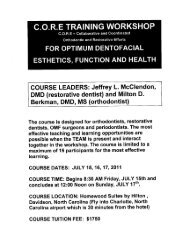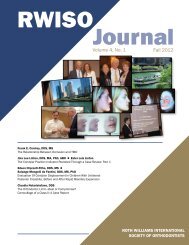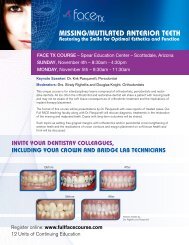2010 RWISO Journal - Roth Williams International Society of ...
2010 RWISO Journal - Roth Williams International Society of ...
2010 RWISO Journal - Roth Williams International Society of ...
You also want an ePaper? Increase the reach of your titles
YUMPU automatically turns print PDFs into web optimized ePapers that Google loves.
to adjust for experimentwide error by reducing our desired<br />
significance level to 0.001.<br />
Measurements<br />
Table 1 Mean values <strong>of</strong> the two face-bow techniques.<br />
Table 1 shows the means and standard deviations for<br />
the arbitrary face-bow technique and the true hinge facebow<br />
technique in the vertical, A-P, and transverse dimensions<br />
with respect to the maxillary right and left first molars and<br />
the maxillary right central incisor. The mean measurements<br />
taken on the cast mounted with a true hinge face-bow were<br />
significantly smaller than those measured on the arbitrary<br />
earpiece face-bow mountings. The standard deviations for<br />
the true hinge face-bow were also one-half to one-third<br />
smaller, indicating less variation around the sample mean.<br />
Results <strong>of</strong> the paired t-test are shown in Table 2.<br />
Table 2 Paired t-tests for differences between<br />
estimated and true hinge technique.<br />
The two face-bow techniques differed significantly in<br />
all three planes <strong>of</strong> space. The mean vertical discrepancy <strong>of</strong><br />
the maxillary right first molar between the estimated and the<br />
true hinge face-bow was 2.19 +/- 2.31 (t = 6.76, df = 50, p<br />
< .001). The mean vertical discrepancy for the maxillary left<br />
first molar was 2.45 +/- 2.21 (t = 7.90, df = 50, p < .001).<br />
The mean vertical discrepancy for the upper right central<br />
was 1.90 +/- 1.75 (t = 7.76, df = 50, p < .001).<br />
The mean difference in the A-P dimension was 3.82 +/-<br />
5.51 (t = 8.163, df = 50, p < .001) for the maxillary right first<br />
molar and 3.10 +/- 2.63 (t = 8.28, df = 50, p < .001) for the<br />
maxillary left first molar. The maxillary right central incisor<br />
showed a mean difference <strong>of</strong> 3.05 +/- 2.62 (t = 8.25, df = 50,<br />
p < .001). Finally, the transverse dimension was evaluated.<br />
The mean difference for the maxillary right first molar was<br />
2.23 +/- 1.33 (t = 12.11, df = 50, p < .001). The mean differ-<br />
ence for the maxillary left first molar was 2.60 +/- 1.49 (t =<br />
11.57, df = 50, p < .001).<br />
The measurement differences in the vertical direction <strong>of</strong><br />
the maxillary right first molar ranged from 0.0 to 3.0 mm.<br />
The measurement differences in the vertical direction <strong>of</strong> the<br />
maxillary left second molar ranged from 1.0 mm to 3.0 mm.<br />
The measurement differences in the vertical direction <strong>of</strong> the<br />
maxillary upper right central incisor ranged from 0.0 to 5.0<br />
mm. The differences in the A-P dimension <strong>of</strong> the upper right<br />
molar ranged from 0.0 to 13.1 mm; <strong>of</strong> the upper left molar<br />
from 0.0 to 15.0 mm; and <strong>of</strong> the upper central incisor from<br />
0.0 to 13.0 mm. The differences in the transverse dimension<br />
ranged from 0.0 to 7.0 mm for the upper right first molar<br />
and from 0.5 to 7.9 mm for the upper left first molar.<br />
Discussion<br />
Mounting dental casts on an articulator allows the clinician<br />
to simulate maxillo-mandibular position in centric relation<br />
and makes possible a visible simulation <strong>of</strong> mandibular border<br />
movements. It has been recommended that mounting<br />
diagnostic dental casts on an articulator should be incorporated<br />
into routine clinical orthodontic practices. 3,46 Recording<br />
the hinge axis and transferring it to an articulator is <strong>of</strong><br />
considerable value in the diagnosis and treatment <strong>of</strong> occlusal<br />
malfunction. 42 In this diagnostic process, a face-bow transfer<br />
is one <strong>of</strong> the first steps in taking accurate intermaxillary<br />
records. Many face-bow techniques are in use today. 20,21<br />
However, this study conducted a comparison <strong>of</strong> only two<br />
face-bow techniques, an arbitrary earpiece face-bow and a<br />
true hinge face-bow.<br />
The null hypothesis for this study: “There is no difference<br />
in the vertical, horizontal, or transverse position <strong>of</strong> the<br />
maxillary cast mounted with a true hinge face-bow versus an<br />
arbitrary earpiece face-bow” was rejected. Paired t-tests indicated<br />
that the maxillary cast position using an arbitrary facebow<br />
transfer was significantly different in all three planes <strong>of</strong><br />
space from the maxillary cast position mounted using a true<br />
hinge face-bow transfer.<br />
In previous comparison studies when the arbitrary earpiece<br />
face-bow is located anywhere along a 5-mm radius <strong>of</strong><br />
the true hinge axis point, some authors have found that the<br />
mandibular arc <strong>of</strong> closure may not be very different from the<br />
true hinge arc <strong>of</strong> closure. 21,26,39,40,42 However, Lauritzen and<br />
Bodner found that in only 33% <strong>of</strong> the 50 patients they examined<br />
did the arbitrary hinge point fall within 5 mm <strong>of</strong> the<br />
true hinge point. In the other 67%, the arbitrary hinge points<br />
were 5 mm to 13 mm away from the true hinge points. Arbitrary<br />
markings <strong>of</strong> the hinge axis introduce severe errors<br />
in mounting casts on an articulator, which may introduce<br />
occlusal errors in the centric jaw relation record. 30 Ricketts<br />
<strong>RWISO</strong> <strong>Journal</strong> | September <strong>2010</strong><br />
51








